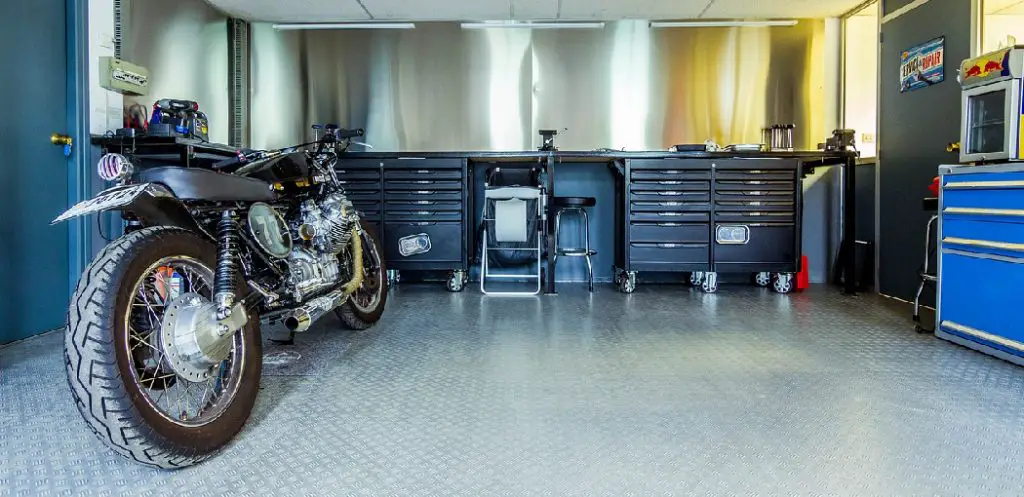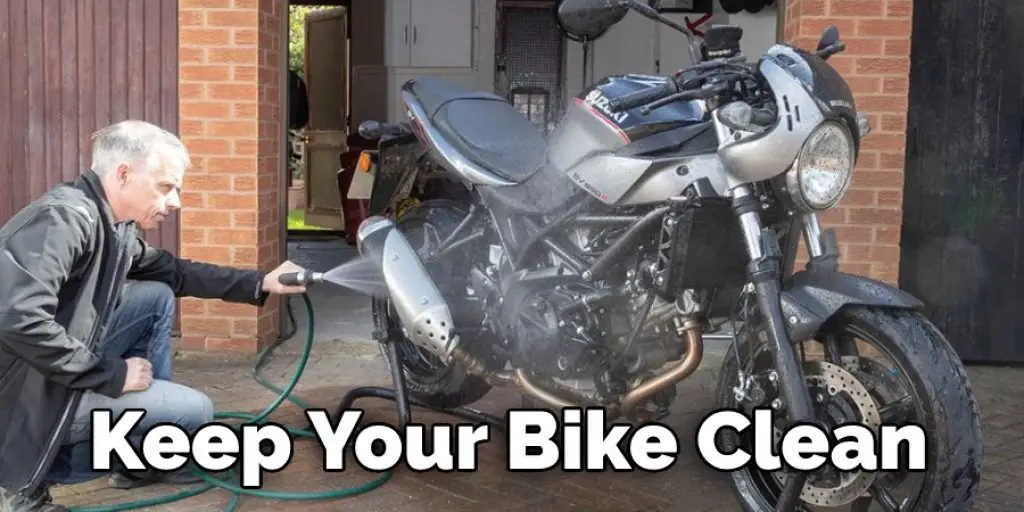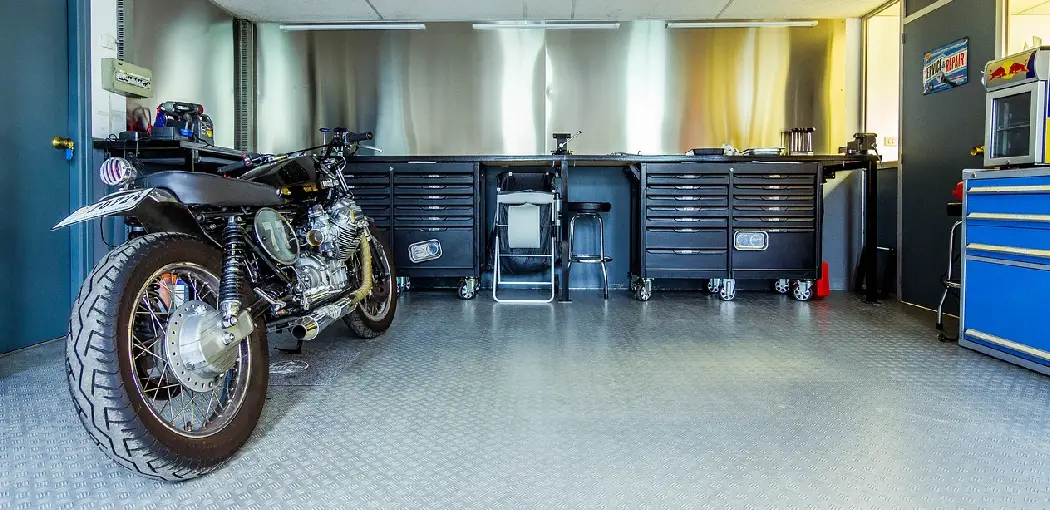If you’re a motorcycle owner, you know how important it is to keep your bike in good condition. But when it comes to storage, there’s more to think about than just protecting your investment. You also need to consider space and whether or not your garage can accommodate your motorcycle. Lucky for you, we’ve put together a list of tips on how to store a motorcycle in a garage. Whether you have a small space or a large one, these tips will help you keep your bike safe and sound. So read on and find out how to store your motorcycle in a garage like a pro!

Motorcycles are fun to get around, but they’re also an excellent investment. That’s why it’s essential to take care of them and store them properly when you’re not using them. If you have a motorcycle and a garage, you’re in luck. Storing your motorcycle in a garage is best to keep it safe from the elements and protect your investment.
Summary: Storing a motorcycle in a garage can protect it from harsh weather conditions and theft. Before parking it in the garage, make sure to clean it thoroughly and check for any maintenance issues. Cover the motorcycle with a breathable, waterproof cover to prevent moisture buildup.
A Detailed Guide on How to Store a Motorcycle in a Garage
Step 1: Clean Your Motorcycle
Before storing your motorcycle, give it a thorough cleaning. Remove any dirt, dust, and debris from the bike using a mild detergent, a sponge, and water. Pay close attention to areas such as the wheels, chain, and engine. Rinse the motorcycle with water, and then dry it completely with a clean, soft cloth to prevent rust and corrosion.
Step 2: Perform Routine Maintenance
Perform routine maintenance tasks before storing your motorcycle to ensure it is in good condition when you’re ready to ride again. Change the engine oil and filter, check the brake fluid and coolant levels, and adjust the chain tension. Additionally, lubricate the chain and any other moving parts to protect them from corrosion during storage.
Step 3: Prepare the Fuel System
To prevent fuel-related issues during storage, fill your motorcycle’s gas tank and add a fuel stabilizer according to the manufacturer’s instructions. This will help prevent the fuel from breaking down and causing damage to the fuel system. Run the engine for a few minutes to circulate the stabilizer throughout the system.
Step 4: Protect the Battery
Disconnect the battery and remove it from the motorcycle. Clean the battery terminals with a wire brush and store the battery in a cool, dry place. To maintain the battery’s charge during storage, connect it to a battery tender or trickle charger.
Step 5: Protect the Tires
Inflate your motorcycle’s tires to the recommended pressure, as this will help prevent flat spots from developing during storage. If possible, elevate the bike using a motorcycle stand or blocks to keep the tires off the ground. Alternatively, you can periodically rotate the tires during storage to redistribute the weight.
Step 6: Protect the Exhaust and Intake
Moisture and pests can cause damage to your motorcycle’s exhaust and intake systems during storage. To prevent this, cover the exhaust pipes and air intake with plastic bags or exhaust plugs. Ensure that the covers are securely fastened and clearly marked to remind you to remove them before starting the motorcycle.
Step 7: Cover Your Motorcycle
Use a breathable motorcycle cover to protect your bike from dust, dirt, and moisture during storage. Avoid using a plastic tarp or cover, as these can trap moisture and cause corrosion. A high-quality motorcycle cover will have vents to allow air circulation and prevent condensation.
Step 8: Choose a Suitable Storage Location
Select a storage location in your garage that is dry, cool, and free from direct sunlight. Avoid placing the motorcycle near windows, doors, or other areas where it may be exposed to temperature fluctuations, moisture, or sunlight. Ensure that the storage area is well-ventilated and free from potential hazards, such as leaks or falling objects.
Step 9: Organize Your Garage
Before storing your motorcycle, take the time to organize your garage to create a safe and efficient storage space. Remove any clutter or obstacles that may pose a risk to your motorcycle, and make sure there is ample room to maneuver around the bike. Store tools, equipment, and other items in designated areas to maintain a clean and organized garage.
Step 10: Secure Your Motorcycle
To deter theft and ensure the safety of your motorcycle during storage, consider securing it with a high-quality lock and chain. Attach the lock and chain to a sturdy, immovable object, such as a wall anchor or heavy-duty floor hook. Additionally, make sure your garage is secured with a reliable lock.
Step 11: Check on Your Motorcycle Periodically
During the storage period, periodically check on your motorcycle to ensure it remains in good condition. Inspect the bike for any signs of corrosion, leaks, or damage, and address any issues promptly. Additionally, rotate the tires to prevent flat spots, and ensure the battery remains charged.
By following these steps, you can safely store your motorcycle in your garage and protect it from damage during the off-season or extended periods of inactivity. Proper preparation, maintenance, and storage techniques will help preserve your motorcycle’s condition and ensure it’s ready to ride when you are.
Step 12: Maintain Proper Temperature and Humidity
Monitor the temperature and humidity levels in your garage during storage. Aim for a consistent temperature between 50 and 70 degrees Fahrenheit and a relative humidity level between 40 and 50 percent. If necessary, use a dehumidifier or heater to maintain ideal conditions and prevent damage to your motorcycle.
Step 13: Change Positions Occasionally
If you do not have a motorcycle stand or blocks, change your motorcycle’s position occasionally during storage. This will help prevent flat spots on the tires and redistribute the weight on the bike. Moving the motorcycle around also allows you to inspect it for any potential issues, such as leaks or corrosion.
Step 14: Prepare for the Riding Season
Before taking your motorcycle out of storage, perform a thorough inspection and necessary maintenance tasks to ensure it’s ready for the riding season. Check the tire pressure, fluid levels, and chain tension, and inspect the brake pads and other components for wear. Remove the exhaust and intake covers, reconnect the battery, and test the lights and horn. Start the engine and let it idle for a few minutes before taking the motorcycle for a test ride.
Step 15: Keep a Storage Checklist
Create a storage checklist to help you remember all the necessary steps for preparing your motorcycle for storage and getting it ready for the riding season. This will make the process more efficient and ensure you don’t overlook any crucial tasks. Store the checklist with your motorcycle gear or maintenance records for easy reference.
By following these comprehensive steps, you can effectively store your motorcycle in a garage and protect it from potential damage during periods of inactivity. Proper preparation, maintenance, and monitoring during storage will preserve your motorcycle’s condition and ensure it’s ready for the road when you are. Investing in quality storage supplies and organizing your garage will also contribute to a safe and efficient storage environment for your motorcycle.
You Can Check It Out to Can I Protect My Treadmill in the Garage
Tips and Warnings
Tips:
– If possible, avoid storing your motorcycle in an unheated garage to prevent the engine and other metal parts from rusting.
– If you must store your motorcycle in an unheated garage, consider investing in a motorcycle cover to protect it from the elements.
– Be sure to disconnect the battery and remove any fragile or valuable items before storing your motorcycle for an extended period.
– Always consult your owner’s manual for specific storage instructions for your particular make and model of motorcycle.
You Can Check It Out to Keep Tools From Rusting in Garage
Warnings:
– Never store a motorcycle in an enclosed space, such as a shed or garage, without proper ventilation. A build-up of carbon monoxide can be deadly.
– Do not start or run the engine while the motorcycle is stored to avoid damaging the engine.
How Do I Stop Condensation on My Motorcycle in My Garage?
If you store your motorcycle in your garage, you may have noticed that it can get quite damp. This is because the temperature inside a garage can fluctuate quite a bit, and when this happens, the air can hold more moisture. This can cause condensation to form on your motorcycle, leading to rust and other damage.

There are a few things you can do to help prevent condensation from forming on your motorcycle:
– Store your motorcycle in a dry spot: If possible, try to store your bike in a place that is not too close to the walls or windows of your garage. This will help reduce the amount of moisture in the air around your motorcycle.
– Use a dehumidifier: If you have a dehumidifier, use it to help keep the humidity in your garage low. This will also help to prevent condensation from forming on your motorcycle.
– Cover your motorcycle: If you can’t store your bike in a dry spot or use a dehumidifier, try to cover it as much as possible. This will help keep the moisture out and reduce the chances of rust forming.
By following these tips, you can help protect your motorcycle from damage caused by condensation in your garage.
Do Motorcycle Covers Cause Rust?
Motorcycle covers are a great way to keep your bike clean and protected from the elements, but some people worry that they might cause rust. There is no need to worry, though, as long as you take a few precautions.

Before you put your motorcycle away for the winter, make sure it is clean and dry. Any moisture left on the bike will be trapped under the cover and could cause rusting. Once your motorcycle is clean and dry, apply a thin layer of oil to all exposed metal surfaces. This will help to create a barrier between the metal and the moisture.
If you live in an area with high humidity, you may consider investing in a dehumidifier for your garage. This will help keep the air inside the garage dry and prevent rust from forming.
When you are ready to put your motorcycle cover on, make sure it is tight-fitting and does not have any holes or tears. If there are any areas where moisture could get in, it could cause rust. It is also a good idea to invest in a cover specifically designed for motorcycles, as these will be made of materials that are less likely to cause rusting.
Following these simple tips will help to ensure that your motorcycle stays in good condition all year long!
Conclusion
Motorcycles take up a lot of space, and many people don’t have the luxury of a designated garage to store their bikes. Suppose you’re one of those looking for creative ways to keep your motorcycle; look no further. We’ve compiled some tips on how to store a motorcycle in a garage so it stays in good condition all year round.
You may read also How to Bypass a Garage Door Sensor


